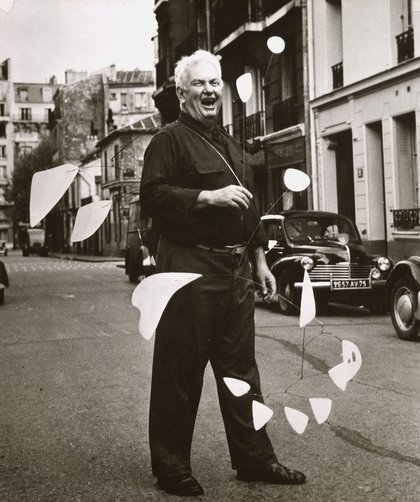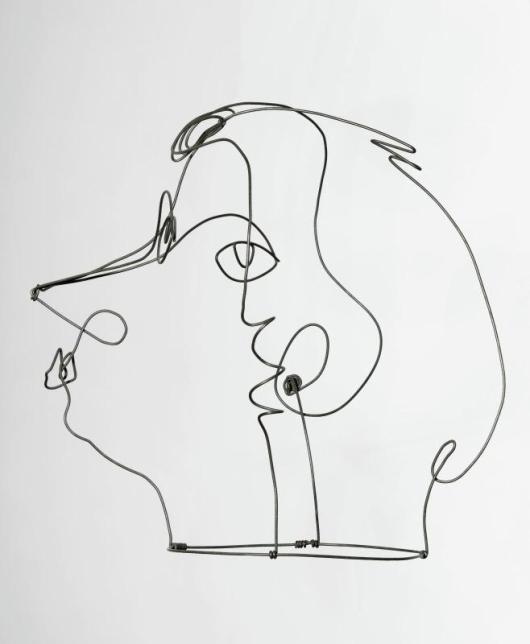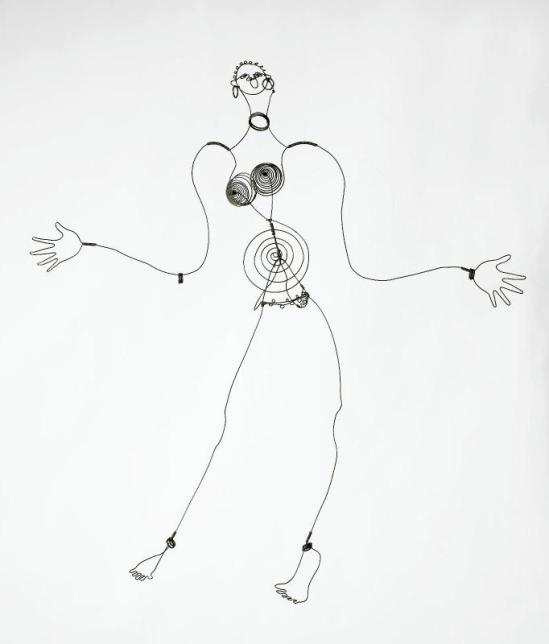What Kind of Art Work Did Alexander Calder Create

Agnès Varda,Calder with 21 feuilles blanches (1953), Paris, 1954
Alexander Calder, the inventor of the "mobile" and kinetic art… he was a chief of gracefully balancing industrial materials with nature, making them piece of work in perfect harmony. This major creative person of the 20th -century inverse the landscape of sculpture, introducing a new and frail slant to this art form. Having worked beside Miro, Arman and Mondrian , today he is one of the most popular artists in the market. He is acclaimed by all the most highly regarded museums in the earth and present in the most prestigious collections. Uncover 10 things to know near this artist who broke with conventions…
He was the pioneer of the mobile and kinetic art

Alexander Calder was the pioneer of the "mobile" that nosotros know today, and the founder of kinetic art. The name "mobile" was gifted by Marcel Duchamp. This new structure broke with the conventions of sculpture in his contemporary setting. Calder'due south sculptures were incredibly delicate and, crucially, they moved. Initially, Calder's sculptures moved due to the use of motors. However, eventually they evolved to move due to natural forces. The sculptures were designed in such a way that they would grab the air currents in a room or the breeze outside, a revolutionary concept in the globe of art. Hand in hand with the introduction of these "mobiles", came the introduction of "stabiles". This proper noun was given by abstruse creative person, Jean Arp, to Calder's previous stationary sculptures.
He is known for 'cartoon in space'

The term 'drawing in infinite' was first used in reference to Calder in the French newspaper Paris-Midi . This came afterwards 1 of his first solo exhibitions in 1929 in which Calder showcased his wire sculptures. The clarification stuck and was often used after to describe Calder'due south works. The term was besides apt for Calder as he would comport bits of wire with him and fashion images of what he saw in the streets. Famously, he enjoyed creating wire portraits of people he met – one of his almost well known was of the extra, Kiki, in 1929. Calder was particularly drawn to her nose which seemed to "launch off into space".
He came from an creative background

Coming from an artistic family, it is not difficult to come across how Calder ended upwards being such a pillar of the art earth, although it was non his parents who pushed him into this career. His father, also chosen Alexander Calder, was a sculptor himself, so he knew the hardships that came with being an artist. He used to call his son 'the garbage human being' as his pockets were ever brimming with pebbles, string and odd bits and bobs.
From an early age Calder showed an interest in sculpture and using his hands to mold the world around him. At the age of 11, his sis bought him a pair of pliers for Christmas. He used these to make 2 little brass sculptures for his mother and begetter, one of a duck and another of a canis familiaris. Metallic went on to be his principal medium. His work uses bits of old wire and wood, showcasing how beauty tin be created out of unwanted scraps.
He was a mechanical engineer turned sculptor

Calder studied mechanical engineering at Stevens Establish of Technology, graduating in 1921. Even so, whilst working on a transport in 1922, information technology was on seeing the cherry sun off the shore of Guatemala that he was reminded of his artistic upbringing. He turned his back on this lifestyle, initially moving to New York where he worked as an creative person for several newspapers until he somewhen moved to the art hub, Paris, in 1926. During his time in Paris he began sketching people in the streets and making fiddling wire figurines in his hotel room. Ane of the first characters he made was Josephine Baker who was renowned across the globe for her Charleston dancing. It was this movement and energy that Calder tried to capture in his models of her.
Although his piece of work never specifically relied on the knowledge he gained during his studies, information technology seems undeniable that his skills influenced his perfectly assembled sculptures. In fact, later in his career he stated: "When I work on something, I have two things in listen. The offset is to make information technology more alive. The 2d is ever to comport in mind the balance of it."
He was always drawn to the circus

Calder sought to stand for and capture movement in all his works throughout his lifetime. This fascination started whilst living in New York. For two weeks he visited the circus, a melting pot for the whole of society. Here he drew and painted the glasses that he saw, trying to capture the animation of the surround. He would return to this inspiration throughout his career.
Later on moving to Paris, Calder created a miniature circus fabricated out of wire and wooden blocks. It included characters such every bit a heavy weight lifter, a horseman and a clown. These were brought to life by Calder pulling unlike strings. His showtime performance was in his hotel room to some of his friends. 1 of these performances attracted Legrand-Chabrier, a renowned circus critic at the time. It was he who was the offset to put Calder in the spotlight, writing an article almost Calder's humble merely genius circus, titled; "Un Petit Cirque à Domicile".
In 1929, Calder linked with Léonard Foujita, the Japanese-French painter and printmaker. Together they worked on Calder'due south circus performances. Calder provided the circus and Foujita the music. These became increasingly pop and artists and intellectuals across Paris became interested. Visitors included the likes of Kiki, Marcel Duchamp, Jean Cocteau and Human being Ray. The circus became so pop that past the beginning of the 30s it had grown from 15 to 200 figurines.
He was inspired past meeting Mondrian

In 1930 Calder was invited to Piet Mondrian'south studio in Paris. Hither Calder was inspired by the colorful squares dotted over the white walls of the studio. With this image, complemented by the low-cal streaming into the infinite, Calder suggested to Mondrian that he prepare the squares into motion. To this Mondrian responded: 'No it is non necessary, my painting is already very fast…'. Nevertheless, this encounter inspired Calder to pursue motion with even more vigour.
Afterwards coming together Mondrian and encountering abstract art for the starting time time, Calder locked himself abroad painting unproblematic canvases that aligned with this thought. However, he speedily grew tired from this medium. But, having been exposed to uncomplicated shapes and arcs, he began to view figurative representation equally limiting. In his next exhibition Volumes, Vectors, Densities at the Galerie Percier, he presented sculptures made from different elements of a circle. Following on from this exhibition, Calder came to be regarded as a serious contender in the world of abstract fine art.
The War Years altered the materials he used for his sculptures

The War Years brought with them a shortage of canvass metal. This posed a problem for Calder who relied on this material to create his masterpieces. Usually he would cut sheet metal into pieces that he would so gather into his mobiles. Yet, this did not phase Calder. Instead the shortage brought with it a new era for Calder who turned to more natural materials. Wood and wire became his new tools. With this new medium, Calder created his Constellations serial in the 1940s, and then called because the sculptures resembled the Cosmos.
He has had multiple behemothic structures displayed across the globe

Later on in his career Calder was often deputed to create giant structures. For example, The Red Spider (1976) and Spiral (1958) in Paris, and Flamingo (1974) in Chicago. In club to create these structures he would get-go make models of them, then they would come to fruition in 1 of his studios. Ane of the largest of these sculptures was Homo (1967) which was installed in Montreal and stood at 65 feet. These monumental sculptures could be plant in cities and the countryside alike and are the principal examples of Calder's "stabiles".
He in one case collaborated with an airline

In 1973, Calder was commissioned to blueprint the outside of an aeroplane in his typical brilliant style by Braniff International Airways. This projection came to exist known as Flight Colours, primarily flying to S America. The outside of the aeroplane, instead of having the airline's logo, had Calder'south signature on the outside. In 1975, he was deputed to decorate another plane, which came to be known as Flying Colours of the United states.
He never wanted to exist divers past a item creative movement

Although mingling with the abstract artists of the day, Calder never sought to be defined by a particular creative movement. In fact he was specifically anti this concept. He was of the opinion that when an artist defined themselves, this was when they became limited. Instead he believed that when an artist was attempting to explicate their work, they should in fact exist challenging their ideas. Virtually his own work, Steel Fish (1934), he stated: 'this is completely useless and meaningless. It'southward just cute, that is all. It tin can make y'all very emotional if you sympathize it, of course, if it had some meaning it would exist easier to understand'.
To conclude, Alexander Calder truly underwent an development throughout his career. From his original wire portraits to his monumental sculptures, Calder'due south creations were the result of true artist exploration. He drew on inspiration from everyone and everything he encountered throughout his life. All the same, he managed to maintain his true to his values and beliefs throughout his life, allowing him to create truly forward thinking sculptures. Ultimately, these qualities meant he completely transformed sculpture as we knew information technology into a lighter and more playful art grade.
Source: https://blog.artsper.com/en/a-closer-look/10-things-know-alexander-calder/
0 Response to "What Kind of Art Work Did Alexander Calder Create"
Post a Comment